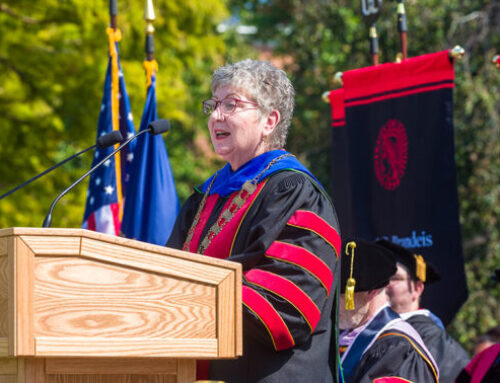By Adam Dahmer–
As Halloween approaches, it is important to remember why it’s worthwhile to celebrate. Not only is Halloween an excellent excuse to dispense with cumbersome social norms like acceptable standards of dress, but it is also one of the oldest continuous traditions in Western Culture. Let us pause to reflect on the ancient history of the holiday.
As many of you may already know, the earliest Halloween traditions originated with the Celtic religious observance known in Ireland and Scotland as Samhain—most authoritatively pronounced “Sah-wen” or “Sah-ven”. For the ancient Celts, the holiday was the one of the most important of the year, and called for three days of celebration beginning one-and-a-half months after the fall equinox. In addition to serving as the Celtic New Year’s celebration and marking the end of the harvest season, Samhain was the time at which the Celts honored their dead.
They believed that during Samhain, the boundaries that separated the realms of the mundane and the supernatural dissolved, allowing gods and ancestor spirits to more easily commune with living people than at any other time of the year. In order to placate the ancestors and other benevolent spirits, the Celts held lavish feasts and sacred ceremonies to which they invited the benign gods and the righteous dead. They also offered gifts to any passersby who happened to arrive at their houses, in case they were otherworldly beings in disguise. This mistake of identity would have been an easy one to make, since many of the human revelers wore outlandish costumes. It was appropriate to dress shockingly on Samhain in order to frighten and bewilder evil spirits who might have accompanied the more pleasant ones on the journey from the Otherworld. The first such disguises probably consisted of animal skins, leathern masks, and liberally applied body paint made from a plant-based blue dye called woad, but they became increasingly sophisticated with the passage of time. From these ancient customs arose the modern Halloween traditions of the Halloween party, the Halloween costume, and trick-or-treating.
In addition to these largely benign activities, observers of Samhain also performed sacrificial rites that by today’s standards seem fairly macabre. These practices varied by region, but all served to venerate the god who oversaw the success of the harvest. For many Celts, this deity was Cernunnos — an antlered, pastoral god of sexuality, death, and rebirth, whose name means “the horned one.” In order to honor him, a votive offering made in his likeness was worshipped, and then was either dismembered or thrown onto a ceremonial pyre. While the ritual murder of a god might seem disrespectful, it was actually a highly reverent act. The god’s passage from life to death symbolized the transition from summer to winter, and broke down the Otherworldly barrier so that other gods and ancestral spirits could enter the world of the living. Furthermore, it underscored the god’s power to overcome death, inviting him to return to life in the spring and cause the crops grow again after the barren agricultural dormancy of winter. In some communities, throwing a hay facsimile of the god into the fire along with a burnt offering of food was sufficient tribute, although more extreme versions of the ritual involved the dismemberment of an animal sacred to the god, or even the execution of human volunteers.
Clearly, the sacrificial aspect of Halloween did not survive to the present day. For this, we can thank, or blame, depending on our feelings about blood rituals, early Christianity. Christian missionaries working to convert the Celts felt less than enthused about a holiday dedicated to the worship of gods who accepted human tributes. To make matters worse, they thought that popular depictions of Cernunnos — crowned with antlers or horns and surrounded by phallic symbols and wild animals — made him look suspiciously like the devil. Church leaders decided early on that the celebration of Samhain had to be quashed, but it was so popular that banning it outright would have made Christianity lose Celtic converts. Cleverly, the clergy decided not to kill Samhain, but to Christianize it. Recognizing that Samhain existed primarily to honor the dead, the Church decided to substitute two Christian holidays that served a similar purpose. These were All Saint’s Day, which satisfied the traditional requirement of honoring the gods, and All Souls’ Day, which served to honor the souls of the virtuous dead. These holidays had existed prior to any attempts to convert the Celts, but had occurred at different times during the year in different parts of Christendom. By fixing them on the 1st and 2nd of November (at about the time when Samhain took place) and allowing them assimilate the existing traditions of feasting, giving alms, and wearing garish costumes, the Christians made the transition from Celtic paganism to their own religion far less daunting for their new converts.
The name Halloween itself occurred with the adoption of Christianity by another pagan people, the Anglo-Saxons. In their language—which with a little help from Norman French eventually evolved into modern English—holy things, including saints, were called halgas, or “hallows”. Thus, they called All Saint’s Day Eal Halgas Daeg, which over time became “All Hallow’s Day.” The day preceding All Hallows Day was All Hallow’s Eve, which popular usage eventually shortened to Halloween.
Even after its transformation from a pagan holiday practiced by primarily by Celts to a Christian Holiday celebrated by various ethnic groups throughout Ireland and Britain, Halloween continued to undergo significant changes. In the Medieval Period, the tradition of feeding guests to appease potential ancestral spirits had been replaced by “souling,” a custom in which children and beggars went door-to-door asking for sweets and baked goods in exchange for prayers for the dead. By the late 19th century, this custom had developed into trick-or-treating, so called because if the beggars and children didn’t get the food they had come for, they would come back later and vandalize the offending house. Pranks associated with trick-or-treating became so costly and damaging that they lead to the condemnation of the practice by the Boy Scouts of America, and caused some city governments to outlaw trick-or-treating altogether. Eventually, the vogue for destruction of property in the absence of candy fell out of favor with the national youth, and trick-or-treating made a comeback.
The resurgence of Halloween was definitely for the best, not only because of its history, but in light of its value to society. Increasingly, Americans as a people are becoming suspicious of strangers and hateful of our neighbors. I don’t argue that the trend is unjustified—the world is a dangerous place, and more so every day, if the media and personal experience are to be believed—but neither should I have to defend my assertion that this sort of climate does not in the least work toward fostering social harmony or spiritual betterment. It is all the more wonderful, then, that on at least one night of the year, children can be prudently encouraged to take candy from strangers, lone female pedestrians can walk the night without fear of being accosted, mobs of masked teenagers can approach houses under cover of darkness without being suspected of harboring malicious intent, and millions of homeowners give gifts to droves of people who on any other night would be trespassers.
Halloween—with its latent paganism, subversive pageantry, death adoration, and flaunting of social norms—is ultimately one of the safest, kindest and most wholesome nights of the year. If our ancestors really do come out to see it, I think it must make them feel proud of the living, and hopeful for the unborn.
Image courtesy of Google Images






